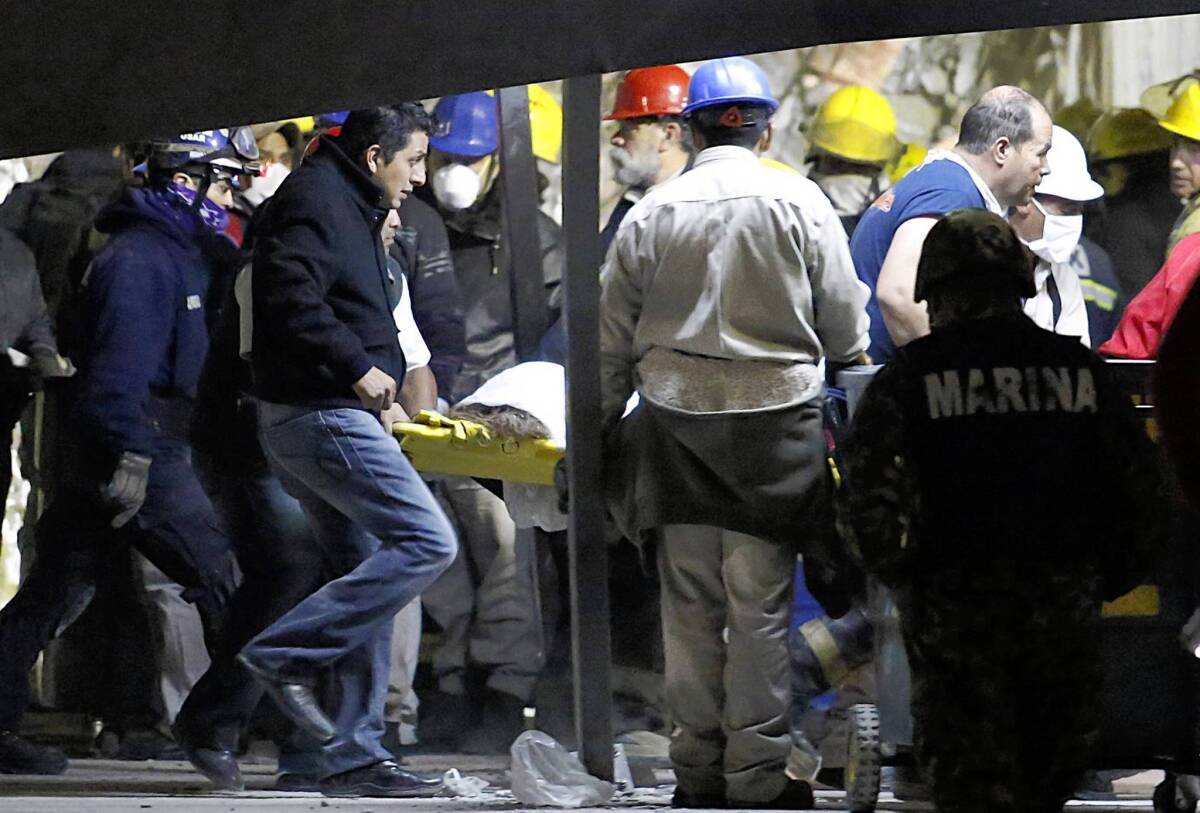Accident suspected in deadly Pemex blast in Mexico

- Share via
MEXICO CITY — With rescue operations winding down, the head of Mexico’s oil monopoly suggested Friday that a huge explosion that claimed at least 33 lives at the company’s headquarters was a calamitous industrial accident.
If confirmed, it would be a scathing indictment of the ability of the giant petroleum exporter to protect, operate and inspect its facilities, experts said. Petroleos Mexicanos, or Pemex, has a long history of lax security, shoddy maintenance, neglected infrastructure, corruption and deadly accidents, as well as incidents of deliberate sabotage.
But rarely has there been anything on the scale of Thursday’s blast at its headquarters, its corporate heart. And officials continued to refuse to pinpoint an exact cause.
More than 120 people were injured and an unknown number may still be missing, authorities said. Rescue crews, including some with expertise honed in response to earthquakes and the Sept. 11 attacks on the World Trade Center in New York, dug through tons of concrete and metal and pulled out several bodies before dawn. Later Friday, searches were suspended as hope of finding more survivors faded.
The blast, whether accidental or deliberate, ripped through four floors of a headquarters administrative building and jolted the next-door 54-story Pemex Executive Tower, an emblematic feature of the Mexico City skyline, at almost exactly the hour workers were finishing a shift, a circumstance that undoubtedly increased the number of casualties.
Emilio Lozoya, director general of Pemex, told reporters, “It appears from what one can observe that this is part of what the experts view as an accident.”
But, he added, “we are not going to discard a single … line of investigation.”
Senior officials Friday also revealed that there was no fire after the blast, which one expert close to the investigation said pointed more toward industrial accident than bombing.
The dead included a 9-year-old girl who had gone to work that day with her dad, and 20 women, possibly employees in the hard-hit human resources department. Sobbing relatives gathered outside the city’s main morgue. Early Friday afternoon, specialists began releasing bodies to families.
The timing of the tragedy could hardly be worse for the powerful, unwieldy and struggling company, and especially for the pledged efforts of new Mexican President Enrique Peña Nieto to turn Pemex around and attract outside investment. Pemex, though a 75-year-old symbol of Mexican nationalistic pride, is also widely seen as a hidebound institution with declining production that lags far behind the international industry standard.
“The whole thing is very damaging for Pemex’s image,” said David Shields, an independent energy analyst in Mexico City. “No matter what happened, it was inside the corporate headquarters. If it was a bomb, how did it get inside? If it was gas or a boiler explosion, how did that happen?”
Security is especially loose at the Pemex complex, just west of downtown Mexico City, Shields noted. People who walk in are screened, but cars driven into the parking bays are not checked. The blast is believed to have originated in a basement garage.
Pemex has chalked up a long string of nearly annual accidents, not always the firm’s fault. The deadliest include a 1984 explosion and fire at a Pemex gas plant on the outskirts of Mexico City, which killed an estimated 500 or more people (an exact toll was never disclosed); and a 1992 event in Guadalajara, in which about 200 were killed when an underground gasoline leak caused streets to literally blow up.
In September, 31 people were killed at a gas plant fire in the Tamaulipas city of Reynosa.
The cutting of pumping lines and siphoning of gas or oil, sometimes by drug traffickers, are common occurrences throughout the Pemex system, and the acts sometimes ignite fires or create leaks that force massive evacuations of area residents.
In 2007, leftist guerrillas bombed numerous pipelines, and other radical groups employing similar tactics have targeted Pemex over the years, though nearly always in the remote areas of the company’s production.
Pemex “has been a disaster in maintenance and in protection of facilities,” said Alberto Islas, a security analyst who has advised the Peña Nieto government. “This is a problem of maintenance, of security and of a lack of oversight over the contractors” to whom Pemex farms out services, he said.
At the site of the oil company’s crippled headquarters, forlorn Pemex workers showed up Friday even though regular business was suspended until further notice. Many said they were eager to return to their jobs as soon as possible, but also anxious to learn the fate of co-workers.
“We’re all asking ourselves the same thing: What happened?” said Carlos Pineda, an accountant who was at his desk on the 10th floor when the blast sent people fleeing. “I really don’t know what could have happened. These are administrative offices, not workshops. There are no solvents or anything like that.”
Handling the fallout from this disaster is an early test for Peña Nieto. More than 24 hours afterward, the government had yet to provide an explanation.
“Every thesis is being examined.… We don’t want to leave anything to the imagination,” Atty. Gen. Jesus Murillo Karam said Friday at a news conference.
But the lack of information left everything to the imagination.
And, in this country where any official explanation is met with profound skepticism, rumors were rampant about what might have happened, and they were sure to grow the longer the government remained circumspect.
“There is a genuine demand,” analyst Shields said, “for the truth to be told.”
Daniel Hernandez and Cecilia Sanchez in The Times’ Mexico City bureau contributed to this report.
More to Read
Sign up for Essential California
The most important California stories and recommendations in your inbox every morning.
You may occasionally receive promotional content from the Los Angeles Times.











